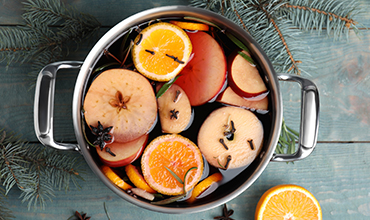Before you put up the tree, light a scented candle, spray holiday air freshener or invite people over, take a minute to learn about seasonal challenges to healthy indoor air quality. During this time of year, we spend more time indoors, breathing the air inside our homes. Simple steps can protect your family from harmful pollutants and virus particles in the air that could make them sick.
Poor Indoor Air Quality Can Make Your Family Sick
The quality of air in our homes has a direct effect on health and well-being. Poor indoor air quality can cause irritated throat, coughing, wheezing and shortness of breath. People with certain conditions, such as asthma, COPD and heart disease, are at increased risk. Exposure to pollutants can worsen their condition. Over time, anyone exposed to poor indoor air quality day after day has a greater risk of developing serious health problems.
Common Indoor Pollutants
Some common indoor pollutants are particulate matter and airborne chemicals. Particulate matter consists of microscopic solid or liquid particles suspended in the air. These particles can come from a variety of sources and vary in size. The EPA says that the size of particles is directly linked to their potential for causing health problems. Of particular concern are particles that are small enough to pass through the nose or mouth and get into the lungs. Smoke from a wood-burning fireplace has the potential to produce these types of particles. Dust from an artificial tree or pollen from a live tree are other sources of particulate matter.
Candles can release harmful chemicals into the air as well. One study found that certain candles produced particulate matter and emissions similar to those contained in exhaust from a diesel engine. Airborne chemicals have been linked to health problems in children.
Eliminate Holiday Pollutants
Here are some easy ways to reduce the level of holiday pollutants in your home:
- Choose candles made from natural ingredients, such as soy, instead of paraffin, a petroleum-based product. They may release lower amounts of harmful emissions. Burn candles in a ventilated room.
- Make your own holiday room scent instead of using a spray or air freshener. Put orange peel, cinnamon sticks and a few cloves in water. Simmer in a saucepan on the stove or in a crockpot. Search “ways to make your home smell like Christmas” for recipe ideas.
- Dust and wipe down holiday decorations to get rid of dust, pollen and mold.
- Rinse off a live tree outside and let it dry before bringing it into the house. Wash the Christmas tree stand before using it.
- Use plastic storage containers instead of those made from cardboard, which can harbor dust and dust mites.
Make Indoor Air Cleaner
Low air exchange rates make indoor air pollution worse. Increased indoor air flow (ventilation) helps flush out indoor pollutants as well as virus particles that spread disease. Here are some ventilation strategies recommended by the CDC:
- Open doors and windows wide. It’s most effective to have several doors and windows fully open to maximize air exchange. But if that’s not possible, even opening a window a few inches can help. Use common sense with this strategy. For example, don’t open the windows if allergens could trigger an asthma attack or a child could fall out of a window.
- Use your HVAC system to help trap virus particles. When people are visiting, set the fan to “on” instead of “auto.” This will keep the air moving. Use pleated filters designed to trap smaller particle size. Make sure the filter fits properly. Change it every three months or as directed by the manufacturer. Annual maintenance is recommended. Incomplete combustion can release carbon monoxide and other harmful byproducts into the air.
- Use fans. Turn on ceiling fans to move the air around. Place a box fan (or other type of fan) so that it blows indoor air out an open window. Don’t point the fan towards people. It could blow contaminated air directly at them.
- Limit the number of people inside your home and how long they stay. The level of virus particles in your home can increase according to the number of people and length of their visit. Try to entertain outdoors. If that’s not possible, gather in larger rooms. Consider asking everyone in your home to wear a mask and keep a distance of six feet apart. Masking and social distancing has been proven to slow the spread of SARS-CoV-2, the virus that causes COVID-19.
- Turn on exhaust fans when you have visitors. Exhaust fans in the bathroom and above the stove may help move air outside. Even if the fan isn’t vented to the outside, it can move air so that virus particles aren’t concentrated in one place. Keep the fans on for an hour after the visitors leave.
Brenda Schoolfield is a freelance medical writer based in Austin.


















